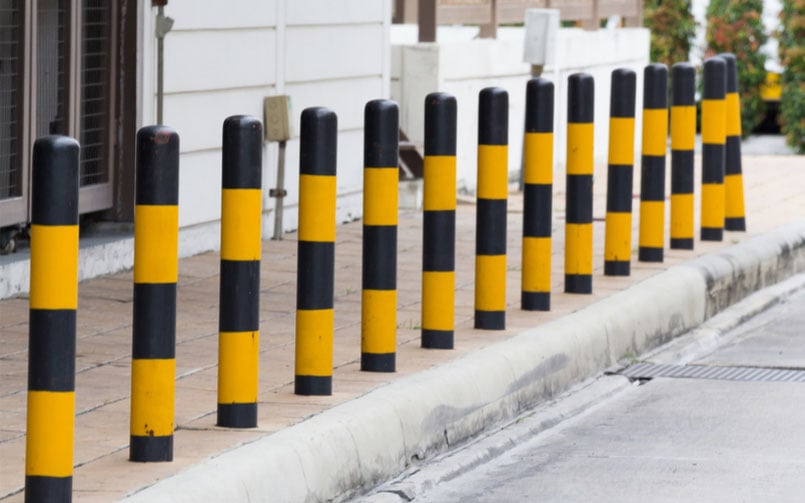When it comes to ensuring security and managing traffic flow, bollards and barriers play a crucial role. However, understanding the difference between these two options and choosing the right one for your specific needs can be challenging. In this article, we will delve into the details of Bollards and barriers, comparing their features, applications, and benefits. By the end, you will have a clear understanding of which option suits your requirements best.
Bollards: Enhancing Security with Style
Bollards are sturdy, vertical posts designed to control and protect areas from unauthorized vehicle access. They are available in various materials, including steel, concrete, and even decorative options. Bollards offer an effective means to prevent accidental collisions, deter potential threats, and guide traffic flow. What are bollards used for? Here are some key points to consider:
Types of Bollards
- Removable Bollards: These bollards can be temporarily removed when access is required, providing flexibility for changing traffic patterns or event management.
- Fixed Bollards: Fixed bollards are permanently installed and offer reliable protection for high-security areas, such as government buildings, airports, or sensitive infrastructure.
- Decorative Bollards: Designed with aesthetics in mind, decorative bollards combine functionality and visual appeal. They are commonly used in urban areas, parks, and commercial spaces.
Applications of Bollards
Bollards find applications in a wide range of settings, including:
- Pedestrian Zones: Bollards create safe spaces for pedestrians, preventing vehicle intrusion and enhancing pedestrian safety.
- Building Perimeters: Bollards secure the surroundings of buildings, preventing unauthorized vehicle access and protecting against potential threats.
- Traffic Guidance: Bollards guide traffic flow, ensuring organized movement and preventing congestion.
Benefits of Bollards
- Security Enhancement: Bollards act as a physical barrier, preventing unauthorized access and protecting vulnerable areas.
- Visual Deterrence: The presence of bollards sends a clear message that unauthorized vehicle entry will not be tolerated, deterring potential threats.
- Flexibility: Removable bollards offer the advantage of adjusting access as needed, while fixed bollards provide permanent protection.
Barriers: Versatility and Control

Barriers, on the other hand, are horizontal structures designed to control the flow of traffic and restrict access. They are available in various types, including gates, fences, and turnstiles, providing versatility for different applications. Let’s explore the key aspects of barriers:
Types of Barriers
- Gates: Gates offer controlled access to designated areas, ensuring only authorized personnel or vehicles can enter. They are commonly used in parking lots, industrial sites, and private properties.
- Fences: Fences provide a physical boundary, preventing unauthorized entry and securing perimeters. They come in different materials and designs, offering options for various security needs
- Turnstiles: Turnstile regulate pedestrian traffic by allowing only one person to pass through at a time. They are commonly seen in transportation hubs, stadiums, and entertainment venues.
Applications of Barriers
Barriers find extensive use in diverse scenarios, including:
- Parking Facilities: Barriers control vehicle access to parking areas, ensuring only authorized vehicles can enter.
- Event Management: Barriers help maintain order and control crowd movement during events, ensuring safety and security.
- Restricted Areas: Barriers restrict access to sensitive locations, such as construction sites, industrial facilities, or restricted zones.
Benefits of Barriers
- Access Control: Barriers provide a mechanism for controlling entry and exit, allowing only authorized personnel or vehicles.
- Safety and Security: By restricting access, barriers prevent unauthorized individuals or vehicles from entering restricted areas, enhancing safety and security.
- Traffic Management: Barriers effectively manage traffic flow, preventing congestion and ensuring organized movement.
Choosing the Right Option
Now that we have explored the characteristics of bollards and barriers, let’s discuss how to choose the right option for your specific requirements. Consider the following factors:
- Security Needs: Assess the level of security required for your premises or area. If high-level security is essential, fixed bollards and robust barriers like gates or fences may be the ideal choice.
- Aesthetics: If visual appeal is a priority, decorative bollards or aesthetically pleasing barriers can enhance the overall ambiance of the space while providing necessary protection.
- Flexibility: Evaluate whether you need the option to adjust access periodically. If so, removable bollards or adaptable barriers like turnstiles could be the optimal solution.
- Traffic Flow: Analyze the traffic patterns and volume in the area. Bollards are effective in guiding traffic, while barriers ensure controlled movement and prevent congestion.
By carefully considering these factors, you can determine the right option that aligns with your specific needs and provides the desired security and traffic control.
Conclusion
Bollards and barriers are essential components of security and traffic management systems. Understanding their differences and choosing the appropriate option is crucial to ensure the safety and efficiency of your premises. We have explored the features, applications, and benefits of both bollards and Barriers, equipping you with the necessary knowledge to make an informed decision.

Remember, when it comes to security and traffic control, there is no one-size-fits-all solution. Assess your unique requirements, consult with experts if needed, and select the option that best suits your specific needs. By doing so, you can create a safer and more organized environment.

